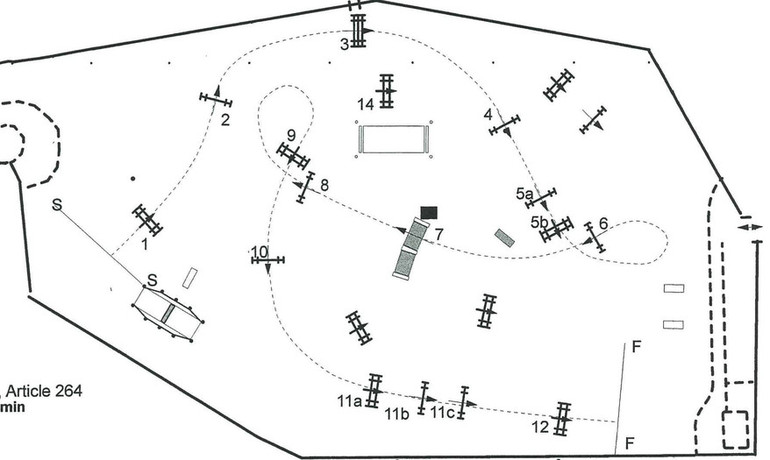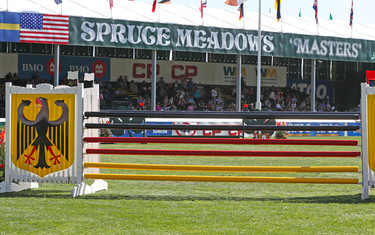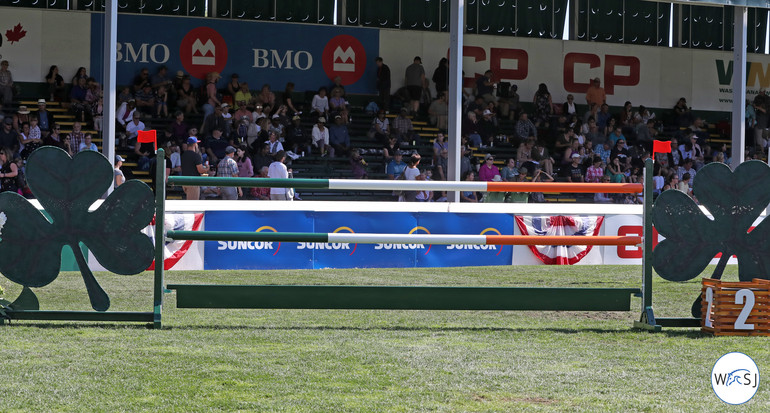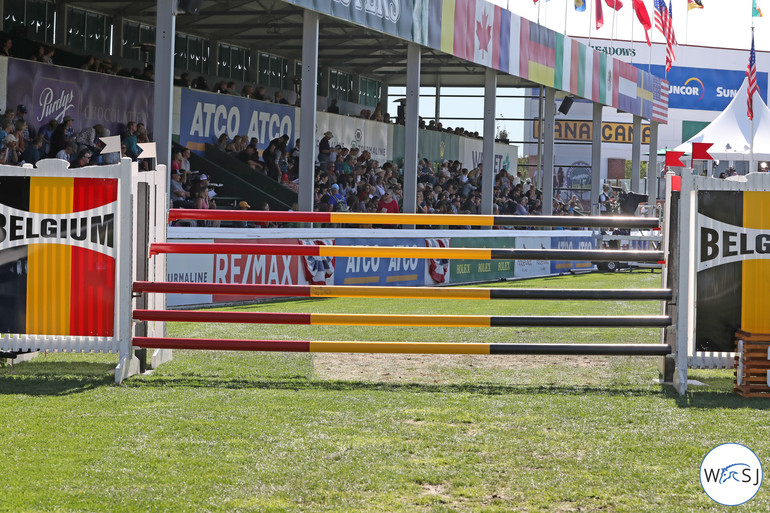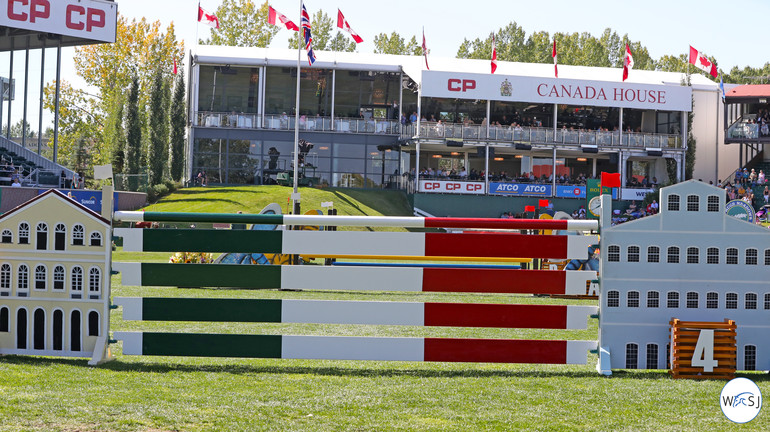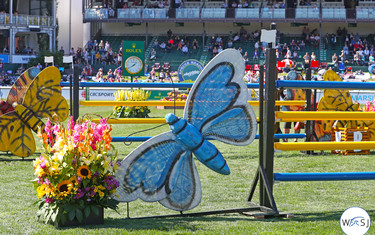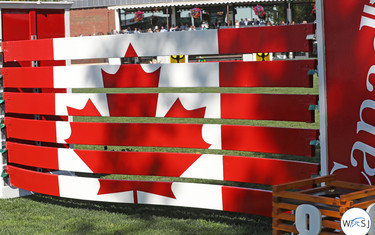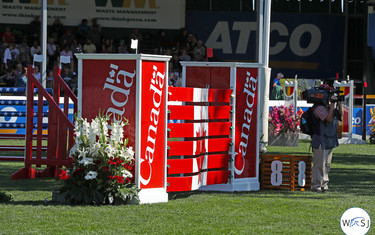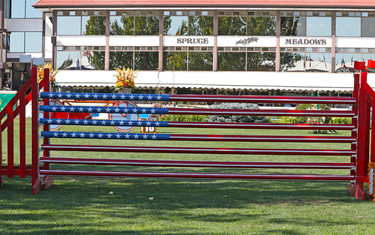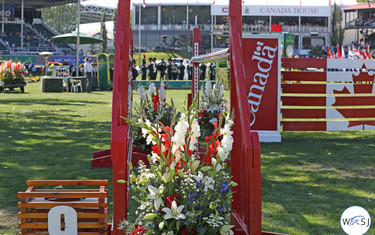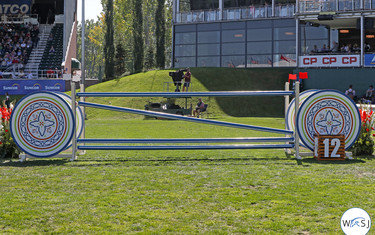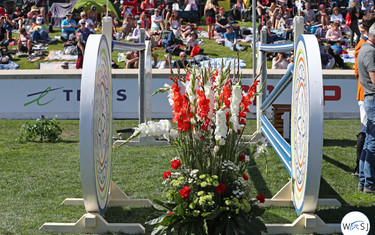During the Spruce Meadows ‘Masters’, Rolex offered a course walk with their testimonee Kent Farrington ahead of the BMO Nations Cup – build by Leopoldo Palacios. Farrington didn’t only explain in which order the fences were about to be jumped, but also what difficulties the different fences, lines and distances could cause for horses and riders. Farrington also shared how he himself would have spend the 45 seconds every rider has before crossing the start line, if he would have competed in the class.
"This end of the arena is typically a little spooky for the horses. It is more a closed space and is pressed up against that screen, so the horses can be a little shy in this end of the ring. It is not such a big fence, but it can ride a bit bigger because of the set-up."
"Here it is a perfect eight strides. Even though the time allowed is short, I still think the riders will do eight here and not try with seven strides. Coming out of the short end of the arena as you do to the first fence, I think it will be spot on with eight strides. Most of the horses have been in the ring quite a few times now and they are comfortable with the ring. Horses that jump in the Nations Cup normally have a lot of experience so it shouldn’t be such a problem to jump in the direction of the audience. For me the issue is rather coming out from the short corner to the first fence."
"If I would ride this myself I wouldn’t go for a count, but with the short time allowed with a bigger strided horse you would probably want a number here as well. It walks nine and a little bit more, so I think the bigger strided horses will do nine since you have to be worried about the time allowed and the smaller strided horses will do ten or even eleven. With it being a triple bar you want to get up close since it is quite wide. This is more a test of stretching the horse out, you want to have a close distance and not be to far away."
"Here again this could be a number with over nine strides. I would not walk this distance to the vertical with a related line to the combination, so I would get a set-up distance to the vertical in order to have the right approach into the combination. For me no. three is a single fence and this again is a single fence and it all depends on what we have into the combination to decide how I would like to approach no. four."
"The combination is a vertical – oxer, so that means I want to come to the vertical as no. 4 slowing down. It is a very short distance on four strides here between the vertical and the combination, so what you want to do is to catch the vertical slow so you are not in a battle to fit in the strides that you want. And you don’t want to be to underneath the vertical in the combination because then the oxer will ride very wide coming out of the combination.
With this being a combination followed with a short distance you might want to come a bit closer to no. four.
So you have the triple bar, which is a stretching jump and then the course designer has set a short distance to a short line and that is the exact opposite, as you want to do at the triple bar. That will be the challenge here for this line to the combination.
Again it is a little bit short inside the combination and the oxer is wide, and that is always difficult for the horse – to first compress their stride and then stretch for the width of the oxer. So it is very important to have the set-up four, to have the horses already on a short canter and a bit slow and jump the vertical slow, so you can give a little bit leg on your way out of the combination to help the horse to stretch."
"This next turn back on the wall is very typical for Leopoldo’s building here at Spruce Meadows. A roll-back like that is a place to make up a lot of time or lose a lot of time. It is to a narrow fence, so it is difficult to turn too short, because then you risk that the horse is not having his eye on the fence and goes out on the side. But if you ride it to wide, you will kill a lot of time and you will get a time fault. It is horse-depending on how short you can turn to that wall.
Most of these horses are experienced horses that have seen walls and things like that many times before. It is more about if you have a careful horse and turn too short and the horse is not really ready for it – it is a big field and a lot of other things that they can put there eye on – it is then an easy thing in a roll-back to the left that the horse can end up going to the right next to the fence."
"You can see what the course designer is doing, everything is sort of one test and then it is repeated by an opposite test coming right after. A short turn roll-back to the wall which is going to have the horses jump high and slow and then the next fence is a water, which is going to be about the horse stretch forward and not about the height.
I would go on an unrelated distance; because I think how the horse lands will depend on your turn and what kind of distance you have on the wall. For me those are two separate exercises. My plan would be to jump this combination, quickly back and jump the wall slow and then start over again with the water as an independent jump.
Water is always a challenge. This requires a good distance of forward strides and a horse that also understand the exercise of reaching for the tape on the backside. You can see that the water is quite big here and it is away from the gate, which is always more of a challenge because the horses’ natural instinct will be to return home. The water jumps much easier in the other direction.
Again, coming off the wall that is a tall jump requiring a lot of height and slow riding and this is the opposite – forward riding and a big stretch. So again the course designer is doing sort of opposite tests back-to-back and that is going to be the challenge of the course. This is also a different box than I have seen before. That can also hold the horses back from the front of the water and then it is harder to reach the tape on the back."
"When I walk the distance after the water I’m guessing where we will land. If I have a horse that drifts in one direction I walk from there.
That walks 6,5 strides to the plank, so that will be very horse-depending on how you plan here. With the field being as big at it is and the short time allowed, I think you are going to see the majority of the horses probably doing an open six strides since the strides get quite big on this sized field. But I think about 25% also adding up and do seven strides to a plank like this. It is a careful fence and it is a plank, but it is also quite imposing so the horses should get a good jump here. On a fence like this it is an advantage to jump it on the side that is caved in so the horse has a little bit more time for the front end."
"We are rolling back here again, similar to the wall at the other end. It is either a time saver or a time killer because you can waste a lot rolling back like this. It is a skinny oxer which when you roll-back the horse often has the back rail because they judge it more as a vertical. It is an easy place to have a back rail fault here."
"It walked a perfect six to the bike fence. When they first introduced this fence, it was very challenging for a lot of the horses but now most of them have seen it already. So they are less afraid of it and it actually rides like a very careful jump. It is quite narrow, which is always harder for the horses to focus on and the poles are quite light. Even the lightest touch will knock that down. It also has very shallow cups.
Even though it walks a perfect six, after that roll-back the six could get a little bit long if you turn short to no. 9 so that is sort of Leopoldo’s test here – he left it up to the rider, either they go out a little bit wider and use up more time to secure a better distance on the six or they turn shorter and make the six a little bit more open – what we call a flat distance which leaves the horses a little bit more tending to knock the top rail down. That is his test here."
"Then it is time for the triple combination. The challenge is that a triple combination towards the end of the course is always difficult because you’re dealing with that the horses have been working on a big, open stride and usually they have a shorter or more technical distance inside. You’re also dealing with the horse being a touch more tired as they come around to the end of the course. They have already done so many efforts jumping and with this being a Nations Cup it will be two back-to-back rounds. I will see the combination towards the end of the course playing a bigger role in the second round than in the first round since the horses will be a touch more tired.
It is an oxer – vertical – vertical, and in a vertical - vertical combination it is always hard to clear both verticals. It is more of an exercise in carefulness and in the horses being able to set up at the end of the course, and not tiring up and knocking that down."
"As you can see at the last fence you have the opposite test. It is an oxer that is not as tall, but wide for the horses to make a short effort here in the combination and to get height and height again for the second vertical and then a touch open distance to stretch out at the end. And that is really a challenge with the horse being a bit tired and coming to the end of the course.
The rider will have to set up their horse and it is very horse-depending on how you want to set up that distance. If you are riding a big scopey horse with a slower front end you will leave more space, and if you are riding a smaller horse where the scope might be in question you want to close up that distance early so that you are not too far away from that final oxer.
As I said, the distance is a little bit open and especially coming off a short vertical-vertical. The five will ride a little bit open and this last oxer is probably the widest of the course so that is going to be a big test there and probably it will pay more of a role in the second round.
For the horses here that are really experienced they are used to see an airy fence like this. If it would be very solid on the front it can ride bigger because the horses will be more imposed to hold of the front rail and on a fence like this you want them to easily cover the back pole."
On a recap on the course:
"If I would ride, I would like to come in early so that I would be able to pass the wall after a short roll-back, pass the water since that is a new box that I haven’t seen before and the horses haven’t also. After they ring the bell, you have 45 seconds to begin and it sounds quite short – but 45 seconds is actually quite a bit of time to get going. So I try to tour around a particular spooky fence or a trouble spot for my horse to give them a little more confidence and also to see it once for myself.
Then as the start being pushed up at that back corner I want to have a strong canter because that first line will probably ride a little more open than it walks, and that was eight strides. Then the triple bar unrelated – get close to that fence so that the horses can stretch, set-up for the vertical and the very short four into the combination which makes it really important to have done that well so that the horses don’t make to much of an effort coming out.
Think of the time allowed back on the wall, try to shorten that as much as I can with the horse that I’m riding. No related distance to the water as I want to come with a strong canter.
Six and a half strides to the vertical so that is going to be six or seven depending on the horse. Jumping a little bit to the right as the fence caves in there, it will then be a slightly easier jump for the horse as if you come on the side that slightly bends out which makes it easier to get a front fault. Roll-back on the skinny oxer that is similar to the wall. Horse-depending on how short you can turn and then set up the next line which is six to the bicycle – it is very important that you have a distance there where you can provide a little support for the front end. It is a very careful fence.
The triple combination coming home, you are always working on the efforts the horse made during the course – that they have enough energy and enough focus for a big combination that is going to ride careful with it being an oxer to two verticals. Open distance, five, to probably the biggest oxer on the course being the final effort. I think that will have a lot of faults – more in the second round than in the first."
No reproduction without permission, copyright © World of Showjumping




